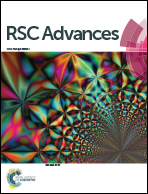Direct syntheses of cucurbit[7]uril-anchored polyacrylic acid microspheres and adsorption of basic dyes by the derivative†
Abstract
A one-pot strategy was employed to synthesize a series of water-soluble cucurbit[7]uril-anchored polyacrylic acids (Q[7]-anchored PAAs) with high yields in the presence of an ammonium persulfate salt as both an initiator and an oxidant. The effects of acrylic acid, Q[7] feed mass and APS concentration on the formation of polymer nanocapsules have been investigated. The Q[7]-anchored PAAs can be further esterified with 2-naphthol to yield water-insoluble derivatives, which are characteristic of the stationary phase for absorption of basic dyes, especially neutral red.
![Graphical abstract: Direct syntheses of cucurbit[7]uril-anchored polyacrylic acid microspheres and adsorption of basic dyes by the derivative](/en/Image/Get?imageInfo.ImageType=GA&imageInfo.ImageIdentifier.ManuscriptID=C5RA09064D&imageInfo.ImageIdentifier.Year=2015)

 Please wait while we load your content...
Please wait while we load your content...